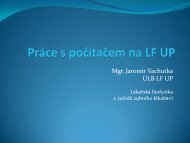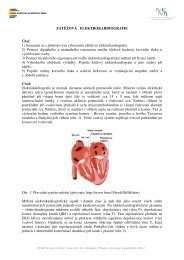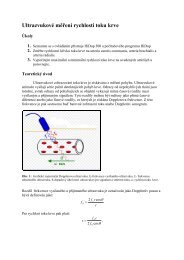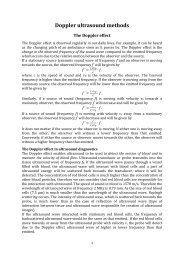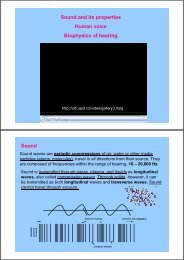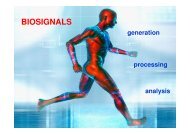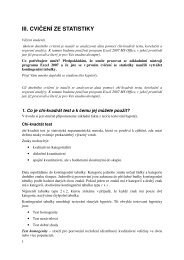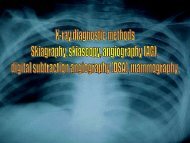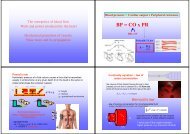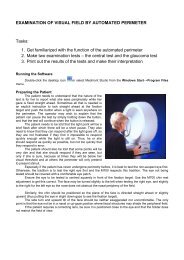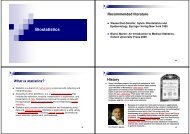1. a) transmembrane (resting) potential, Nernst equation, Goldman ...
1. a) transmembrane (resting) potential, Nernst equation, Goldman ...
1. a) transmembrane (resting) potential, Nernst equation, Goldman ...
- No tags were found...
Create successful ePaper yourself
Turn your PDF publications into a flip-book with our unique Google optimized e-Paper software.
List of Questions (Topics) for the Examinationin Medical Biophysics, Biometrics and Computer Technology<strong>1.</strong> a) <strong>transmembrane</strong> (<strong>resting</strong>) <strong>potential</strong>, <strong>Nernst</strong> <strong>equation</strong>, <strong>Goldman</strong> <strong>equation</strong>b) physiological functions of the lungsc) comparative method of an emitter activity measurement, calculation of the linearattenuation coefficient from given values of a beta radiation absorption2. a) function of receptors, classification, sensory modalitiesb) exchange of respiratory gases, alveolocapillary barrierc) method of a beta radiation absorption curve measurement, calculation of the linearattenuation coefficient from given values of a beta radiation absorption3. a) receptor (generator) <strong>potential</strong>b) intrapleural and intrapulmonary pressuresc) function of the Geiger-Müller counter and its basic parameters4. a) action <strong>potential</strong>b) lung volumes and capacitiesc) spectrophotometric measurement of a solution concentration5. a) action <strong>potential</strong> of the cardiac muscleb) breathing and regulation of the blood-pHc) spectrophotometer, physical characteristics of the light6. a) decompression sicknessb) electrocardiography, electrocardiogram, leadsc) refractometry, measurement of a solution concentration7. a) blood pressure, pulse pressure, mean arterial pressureb) vision - function of the retinac) refractometer, refractive index, and its temperature dependence of a solution8. a) oncotic pressure, transcapillary exchange of fluids, edemab) vision - colour vision, colour deficienciesc) indirect measurement of the blood pressure using both, the manual and automatictonometers, accuracy of the measurement9. a) active transportb) hearing - function of the external and middle earc) measurement of viscosity with the Stokes viscosimeter10. a) passive transportb) hearing - function of the inner earc) measurement of the liquid surface tension1<strong>1.</strong> a) cell membraneb) spirometryc) measurement of the skin impedance, and its real (resistance) and imaginary (capacity)component.
12. a) resistence to flow in the cardiovascular systemb) sound, basic characteristics, generationc) measurement of the body temperature, difference between the digital thermistor andmercury thermometer13. a) laminar and turbulent blood flow, critical Reynolds numberb) Helmholtz’s resonator theory of hearingc) measurement of the blood flow velocity in arteries using ultrasound14. a) cardiac output, stroke volume, ejection fractionb) von Bakesy’s theory of hearingc) spirometry measurements15. a) radioactivity, radioactive decaysb) hearing deficiency (losses)c) ECG recording, main leads, ECG trace waves, calculation of the heart rate from thegiven record16. a) interaction of ionizing radiation with matterb) major function of the tectorial membrane in the cochleac) construction of the electric heart axis from the given ECG record17. a) Doppler effectb) electrooculographyc) principle of distance (thickness) measuremnt of anatomical structures by ultrasound18. a) X-rays generation, braking and characteristic radiationb) changes in alveolar and intrapleural pressure that occur during inspiration andexpirationc) methods of the visual acuity examination, optotypes19. a) Computed tomographyb) Starling forces that determine the net movement of fluid across the capillary wallc) ophthalmoscopy20. a) lasers and their application in medicineb) various parts of the eye and their functionsc) measurement of a differential energy spectrum of unknown radioactive emitter2<strong>1.</strong> a) classification of biosignalsb) hyperopia, myopia, astigmatism, presbyopia, and strabismusc) determination of unknown radioactive emitter using the nuclear differential energyspectrum analyser for gamma particle energy measurement22. a) radiation illnessb) colour visionc) audiometry, air and bone conduction examination23. a) electrotherapyb) main biophysical functions of the middle earc) audiogram, the reason of dB scale usage
24. a) molecular properties of gasses, Dalton’s law, Henry’s lawb) magnetic resonance imaging – physical principlec) Short Increment Sensitivity Index - recruitment measurement of hearing25. a) refractive mechanism of the human eye and formation of an image on the retinab) composition of plasma, interstitial fluid, and intracellular fluidc) examination of the visual field with automated perimeter26. a) intermolecular forcesb) chemical senses - gustation and olfactionc) principles of the two - dimensional B-mode ultrasound scanning, physical background,type of transducers, shape of picture27. a) diffusion - Fick’s lawsb) electroencephalography, waves, leads, evoked <strong>potential</strong>sc) foetal age estimation by ultrasound scanning, methods of scanning, frequencies used28. a) osmosis, osmotic pressure, osmolarity, osmolalityb) obstructive and restrictive ventilation defectsc) descriptive statistics, types of data, mean, median, mode, standard deviation29. a) peripheral vessel resistance, Poiseulle’s lawb) ultrasound - characteristics, generation and application in medicinec) sceening test, its sensitivity and specificity30. a) preload, afterload, heart contractility, Starling’s lawb) magnetic resonance imaging – basic imaging modesc) hypothesis testing, basic steps3<strong>1.</strong> a) stochastic and deterministic effects of ionizing radiationb) electroretinographyc) t – tests (Student’s tests, one sample, 2 independent samples, paired)32. a) electrolyte and acid-base imbalancesb) digital subtraction angiographyc) non - parametric tests (Mann-Whitney U-test, Wilcoxon signed ranks test)The exam enrollment must be strictly carried out via STAG (university study system). Prior tothe enrollment, each student must be granted course credits for both the winter and summerpractical training.Before answering questions, an individual written preparation for maximally 20 minutes isavailable. During this time, the student must not leave the room.Calculators, mobile phones or other electronic devices are prohibited. No bags, books or otherstudy materials can be placed on a desk during the preparation.To pass the exam you have to achieve the lowest individual grade E from all 3 sub-questions!




